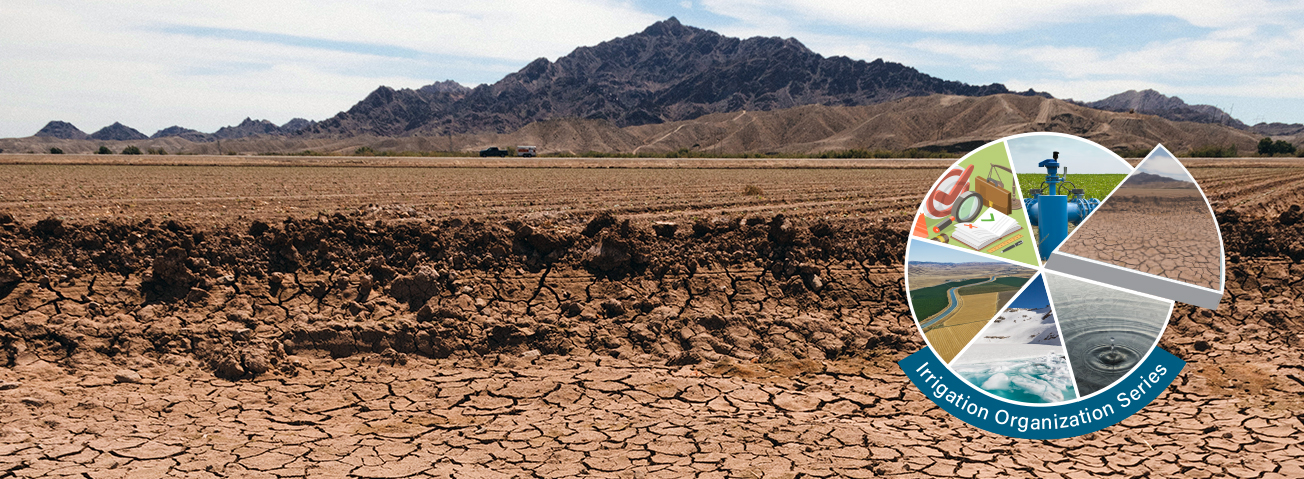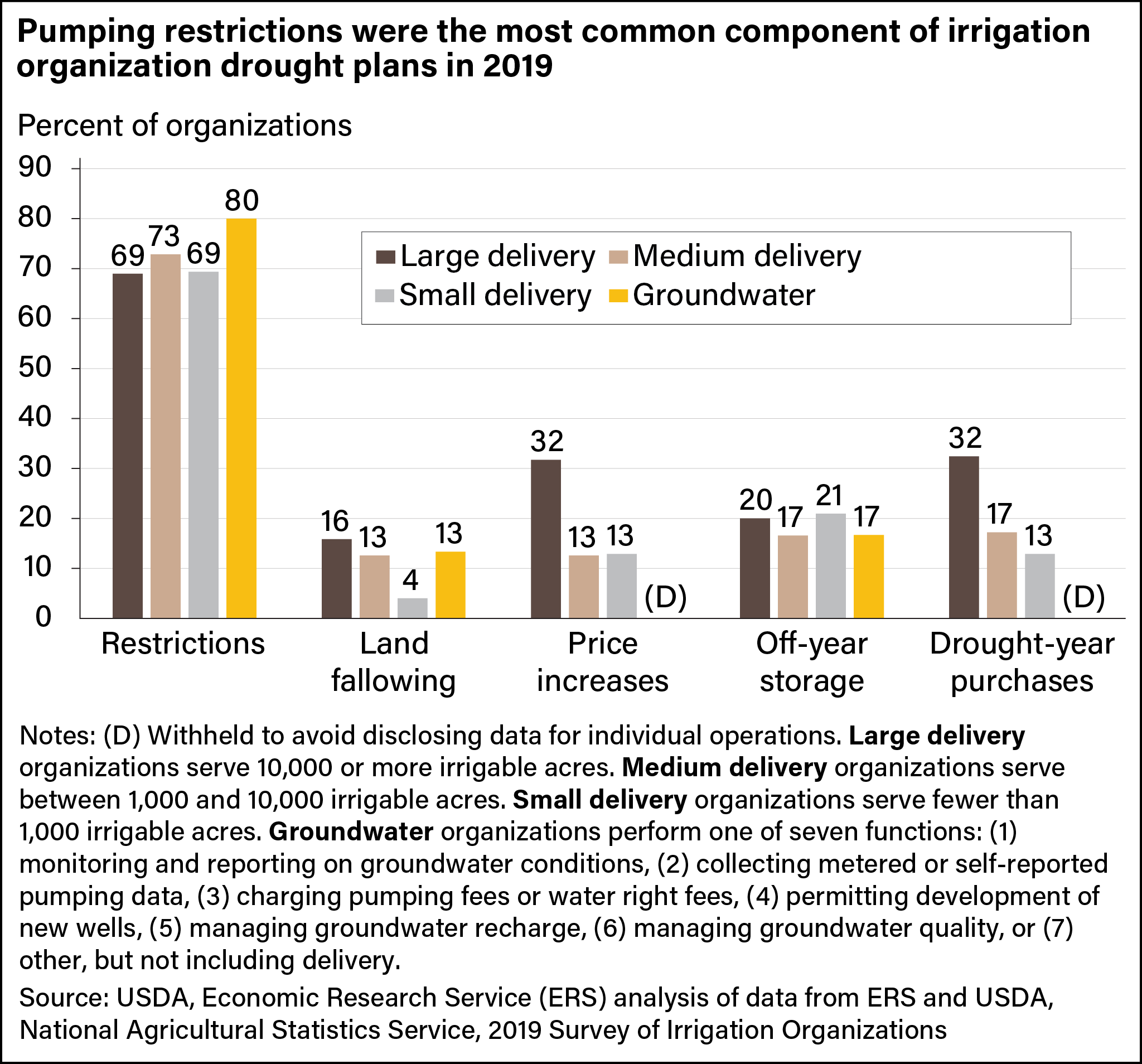
Some Irrigation Organizations Rely on Formal Drought Plans
- by Steven Wallander, R. Aaron Hrozencik and Marcel Aillery
- 2/22/2022
Many irrigation organizations develop drought plans that provide guidance to farmers and other water users on how the organizations plan to respond in the event of a drought. USDA’s Economic Research Service and National Agricultural Statistics Service jointly produced the Survey of Irrigation Organizations (SIO) in 2019. The 2019 survey provided the first updated dataset of local water-supply management entities since the 1978 Census of Irrigation Organizations. The SIO provides details on how irrigation organizations plan for and respond to drought.
About one-fifth of irrigation organizations have a formal, written drought plan. Drought planning is most common among large delivery organizations that serve more than 10,000 irrigable acres. Large delivery organizations, which collectively served about 80 percent of the acreage that could have received off-farm water in 2019, are likely to have greater staff and financial resources to develop a formal plan. About two-fifths of large organizations have a formal, written drought plan. Drought planning is also common for irrigation organizations that manage groundwater but do not deliver water to farms. Groundwater organizations, as defined in this survey, perform at least one of seven roles, such as monitoring groundwater use or permitting new wells, that directly influence on-farm groundwater use. Formal planning is least common among small delivery organizations serving 1,000 or fewer irrigable acres. One reason smaller organizations are less likely to have a formal plan might be that as more acreage and users are involved, coordination of irrigation water use becomes more complex. However, a formal planning process could provide greater benefits to a wider set of users.
The most common component in formal drought plans is a set of protocols for how water delivery or pumping restrictions, often referred to as curtailments, would be implemented. Between 68 and 80 percent of irrigation organizations, depending on their type and size, include details about delivery or pumping restrictions in their formal plans. Additional questions in the SIO revealed that organizations tended to use similar approaches for managing water curtailments regardless of whether or not they had a drought plan, which suggests that drought plans may be more of a tool for committing to certain drought response strategies in advance rather than a means for changing those strategies.
In some cases, organizations use special pricing that increases water delivery charges or pumping charges during a drought. Higher water prices during the drought season incentivize farmers to reduce water use while helping organizations recover a share of revenue losses caused by reduced deliveries and/or the purchase of additional water supplies. About one-third of the plans for large delivery organizations address expected increases in the price charged for water deliveries or the intent to purchase additional water supplies in the event of drought. Only about 10 to 13 percent of other delivery organizations include drought pricing in their plans.
Some drought plans include specific provisions to increase water supply for irrigators. This can be done either by purchasing additional supplies during a drought or by increasing storage in reservoirs or aquifers during nondrought years as a buffer against supply shortfalls in drought years (known as water banking). About 30 percent of large organizations’ plans indicate intent to increase water supply during drought years, compared with only about 12 to 15 percent of other organizations’ plans. Between 15 and 21 percent of all plans specify an intention to use water banking.
Land fallowing, a farming technique that leaves a plot of land uncultivated for a season or more, is a less common component of formal drought plans. In a drought plan, organizations may have provisions for compensating farmers who fallow land or for requiring some form of land fallowing. Land fallowing provisions are included in only 12 to 15 percent of plans for medium and large delivery organizations and groundwater organizations but just 4 percent of small delivery organizations’ plans. For areas served by organizations that do not have fallowing provisions in their drought plan, there is still likely to be some fallowing during drought, but these decisions will be at the farm level without direct input or explicit fallowing incentives provided by the irrigation organization.
This article is drawn from:
- Wallander, S., Hrozencik, R.A. & Aillery, M. (2022). Irrigation Organizations: Drought Planning and Response. U.S. Department of Agriculture, Economic Research Service. EB-33.
You may also like:
- Rosenberg, A.B. (2020, October 5). Incentives to Retire Water Rights Have Reduced Stress on the High Plains Aquifer. Amber Waves, U.S. Department of Agriculture, Economic Research Service.
- Schaible, G. (2017, June 5). Understanding Irrigated Agriculture. Amber Waves, U.S. Department of Agriculture, Economic Research Service.
- Irrigation & Water Use. (n.d.). U.S. Department of Agriculture, Economic Research Service.
- Wallander, S., Marshall, E. & Aillery, M. (2017, June 5). Farmers Employ Strategies To Reduce Risk of Drought Damages. Amber Waves, U.S. Department of Agriculture, Economic Research Service.
- Marshall, E., Aillery, M., Malcolm, S. & Williams, R. (2015). Climate Change, Water Scarcity, and Adaptation in the U.S. Fieldcrop Sector. U.S. Department of Agriculture, Economic Research Service. ERR-201.


